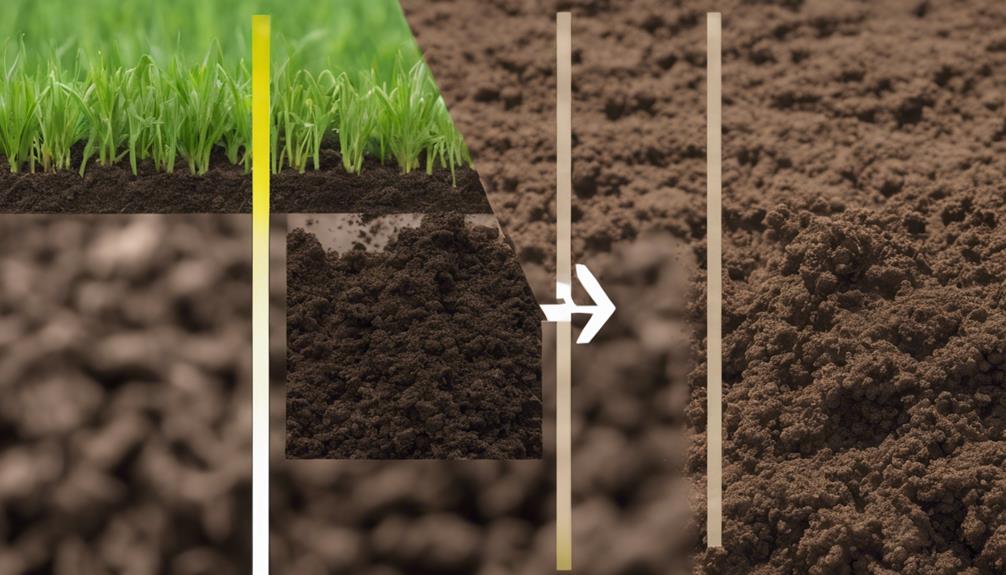Why Does Natural Farming Enhance Soil Fertility?
When you observe how a field that has been conventionally farmed for years transitions to natural farming practices, you might notice a significant change in the soil's vitality.
The shift to natural farming techniques has been increasingly praised for its ability to revitalize depleted soils and boost fertility levels.
But why exactly does this happen?
Well, the answer lies in the intricate relationships between the soil, plants, and a multitude of tiny organisms that play a crucial role in nurturing the land.
Microbial Diversity in Soil
To understand the intricate ecosystem of soil health, consider the vast array of microbial life thriving beneath your feet. Beneficial microbes play a crucial role in maintaining soil health by promoting nutrient cycling, improving soil structure, and suppressing harmful pathogens. These tiny organisms, such as bacteria, fungi, and protozoa, form a complex web of interactions that contribute to the overall fertility of the soil.
Beneficial microbes break down organic matter, releasing essential nutrients like nitrogen, phosphorus, and potassium that are vital for plant growth. They also help in decomposing plant residues, turning them into humus—a stable form of organic matter that improves soil structure and water retention capacity. Moreover, these microbes create symbiotic relationships with plant roots, aiding in nutrient uptake and enhancing plant resilience to stressors.
Increased Soil Organic Matter
Beneficial microbes play a pivotal role in increasing soil organic matter, contributing significantly to soil fertility and overall ecosystem health.
When practicing natural farming methods, you're actively promoting the enhancement of soil organic matter through various mechanisms:
- Carbon Sequestration: By fostering a diverse microbial community in the soil, you're aiding in the sequestration of carbon. Microbes help convert organic matter into stable forms of carbon, which are then stored in the soil. This process not only improves soil health but also mitigates the effects of climate change by removing carbon dioxide from the atmosphere.
- Soil Health: The increase in soil organic matter results in improved soil structure, moisture retention, and nutrient availability. This fosters a healthier environment for plants to thrive, promoting overall agricultural productivity and sustainability.
- Sustainable Agriculture: Natural farming practices enhance the soil's capacity for carbon storage, making it an essential component of sustainable agriculture. By increasing soil organic matter content, you aren't only enriching the soil but also contributing to long-term soil fertility and resilience.
Incorporating these practices into your farming methods can lead to a more robust ecosystem, where soil fertility is enhanced, and the benefits of carbon storage are realized.
Nutrient Cycling Efficiency
Improving nutrient cycling efficiency in your soil is crucial for maximizing plant growth and optimizing agricultural productivity. By efficiently cycling nutrients, such as nitrogen, phosphorus, and potassium, you can enhance soil health and promote better crop yields. Efficient cycling ensures that essential nutrients are readily available for plants, leading to improved nutrient uptake and utilization.
One key benefit of enhancing nutrient cycling efficiency is the promotion of carbon sequestration in the soil. When nutrients are cycled effectively, organic matter accumulates, which aids in trapping carbon from the atmosphere and storing it in the soil. This process not only helps mitigate climate change by reducing greenhouse gas levels but also contributes to improved soil structure and fertility.
Moreover, optimizing nutrient cycling boosts nutrient availability for plants, fostering increased growth and productivity. By ensuring that nutrients are recycled and not lost through leaching or runoff, you can sustainably support crop development and overall ecosystem resilience. Healthy soils with efficient cycling systems are better equipped to withstand environmental stressors and fluctuations, making your agricultural practices more sustainable in the long run.
Enhanced Soil Structure
Enhancing nutrient cycling efficiency not only contributes to carbon sequestration but also plays a vital role in shaping the enhanced soil structure. This improved structure is crucial for promoting healthier soil conditions that support plant growth and overall soil health.
- Improved Aeration: Enhanced soil structure allows for better air circulation within the soil, facilitating the exchange of gases necessary for plant respiration and microbial activity. This increased aeration prevents the soil from becoming compacted, which can impede root growth and water infiltration.
- Enhanced Root Growth: A well-structured soil provides an optimal environment for root development. With improved soil structure, roots can penetrate deeper into the ground, accessing more nutrients and water. Stronger root systems lead to healthier plants that are more resilient to stressors such as drought and diseases.
- Increased Water Retention: The enhanced soil structure promotes better water retention capacity. It allows the soil to hold onto moisture for longer periods, reducing the frequency of irrigation needed. This not only conserves water but also ensures that plants have a more consistent water supply, leading to more stable growth and higher yields.
Reduction in Soil Erosion
To prevent soil erosion, implementing natural farming practices is essential. By adopting techniques such as minimal tillage, cover cropping, and agroforestry, you can significantly reduce the risk of soil erosion. Natural farming methods help in preventing degradation of the soil structure and promoting sustainability in agricultural systems.
One of the primary reasons natural farming aids in reducing soil erosion is due to the preservation of soil structure. When you disturb the soil less frequently through minimal tillage practices, you allow the soil to maintain its natural composition, making it more resistant to erosion caused by wind or water. Additionally, cover cropping, where plants are grown to shield the soil, helps in anchoring the soil in place, preventing it from being washed or blown away.
Agroforestry, another technique used in natural farming, involves integrating trees and shrubs into agricultural landscapes. The roots of these trees help bind the soil particles together, reducing the chances of erosion. By incorporating these methods into your farming practices, you can protect the soil from degradation and ensure the long-term sustainability of your land.
Improved Water Retention
Preserving soil structure through natural farming practices not only reduces soil erosion but also enhances the soil's ability to retain water effectively. This improvement in water retention is crucial for promoting root development and overall soil health, leading to increased crop yield and supporting sustainable agriculture practices.
- Root Development: With improved water retention, plants have better access to water in the soil, allowing their roots to grow deeper and stronger. This results in healthier plants that are more resilient to environmental stressors.
- Soil Health: Enhanced water retention helps maintain a balanced soil ecosystem by providing a consistent moisture level for essential soil organisms. These organisms play a vital role in nutrient cycling and overall soil fertility.
- Crop Yield and Sustainable Agriculture: By retaining water more efficiently, natural farming methods contribute to higher crop yields. This increased productivity supports sustainable agriculture by reducing the reliance on synthetic inputs and promoting long-term soil health.
Soil Ph Balance

Maintaining the proper pH balance in your soil is essential for ensuring optimal plant growth and nutrient availability. Soil pH directly impacts soil microbial activity, which in turn affects the availability of essential nutrients for plants. When the pH level is within the ideal range, typically between 6.0 and 7.0, beneficial microbes thrive, aiding in nutrient cycling and making nutrients more accessible to plants. This optimal pH environment supports robust plant growth and maximizes yield potential.
A balanced soil pH is crucial as it influences the availability of key nutrients like nitrogen, phosphorus, and potassium. When the pH strays too far from the optimum range, nutrient availability can be compromised, leading to stunted growth and reduced yields. Additionally, certain micronutrients become more or less available depending on the soil pH, further emphasizing the importance of maintaining a balanced environment for your plants.
Decreased Chemical Inputs
Reducing reliance on chemical inputs can significantly benefit your soil health and overall ecosystem. By embracing sustainable agriculture practices that focus on decreased chemical inputs, you can enhance the long-term fertility of your soil while minimizing the environmental impact of your farming activities.
When you reduce chemical inputs on your farm, you can experience the following benefits:
- Enhanced Soil Microbial Activity: By decreasing the use of synthetic fertilizers and pesticides, you allow beneficial soil microbes to thrive and support nutrient cycling, leading to healthier soil.
- Improved Water Quality: Reducing chemical inputs helps prevent water contamination from runoff, safeguarding water quality for both your farm and the surrounding environment.
- Promotion of Biodiversity: Embracing natural farming practices encourages a diverse range of organisms to inhabit your soil, promoting a balanced ecosystem that can better withstand environmental stressors.
Frequently Asked Questions
How Does Natural Farming Impact the Biodiversity of Insects and Other Small Organisms in the Soil?
When you adopt natural farming practices, the biodiversity of insects and other small organisms in the soil tends to flourish. This boost in biodiversity is beneficial for soil health as it promotes microbial diversity, which in turn enhances soil fertility.
Can Natural Farming Practices Help Mitigate the Effects of Soil Compaction?
Natural farming practices can help mitigate the effects of soil compaction by improving aeration and water infiltration. This can enhance soil structure and promote healthier root growth.
Implementing techniques like minimal tillage, cover cropping, and mulching can reduce compaction, allowing roots to penetrate deeper and access nutrients more effectively.
What Role Do Cover Crops Play in Enhancing Soil Fertility Through Natural Farming Methods?
Cover crops are essential in enhancing soil fertility through natural farming methods. By incorporating crop rotation, they help improve nutrient cycling and maintain soil structure.
Additionally, cover crops play a vital role in weed suppression, allowing for healthier soil ecosystems. Their presence not only adds organic matter to the soil but also facilitates the retention of moisture and nutrients, ultimately contributing to improved soil fertility in a sustainable manner.
How Does Natural Farming Affect the Release of Greenhouse Gases From the Soil?
When you practice natural farming, soil health improves, reducing greenhouse gas emissions. By utilizing methods like cover cropping and composting, you enhance soil structure and microbial activity.
This fosters a healthier environment underground, which can lead to a decrease in greenhouse gases released from the soil. Overall, natural farming techniques play a significant role in mitigating the impact of agriculture on greenhouse gas emissions.
Are There Specific Natural Farming Techniques That Can Help Restore Degraded Soils More Effectively Than Conventional Methods?
To restore degraded soils effectively, natural farming techniques focus on water conservation and enhancing soil structure. Practices like nutrient cycling and promoting microbial diversity play a key role.
These methods can outperform conventional techniques by fostering healthier soil ecosystems, which ultimately lead to improved soil fertility and productivity. By incorporating these strategies into your farming approach, you can revitalize degraded soils more efficiently and sustainably.
Conclusion
In conclusion, natural farming practices enhance soil fertility by promoting microbial diversity, increasing soil organic matter, improving nutrient cycling efficiency, enhancing soil structure, reducing erosion, improving water retention, balancing soil pH, and decreasing the need for chemical inputs.
These methods work together to create a sustainable and healthy environment for plants to thrive, ultimately leading to higher yields and healthier crops.
So, keep up the good work and continue practicing natural farming for a more fertile soil!
